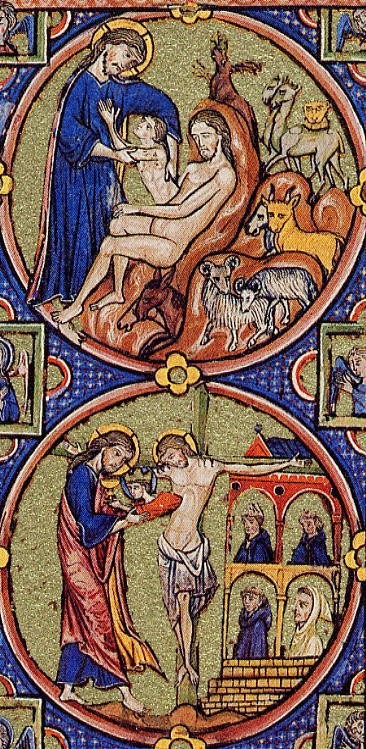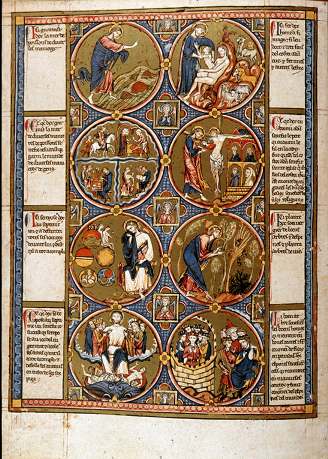Bible moralisée - VM - Victoria Emily Jones
Bible moralisée: The Birth of Ecclesia

Our Sweet, Travailing Mother Christ
by Victoria Emily Jones
Bibles moralisées (moralized Bibles) are lavish picture books originating in thirteenth-century France that pair episodes from scripture with allegorical interpretations—image interpreting image. Captions are given, but the pictures dominate and do the main interpretive work.
The Bible moralisée known as Vienna 2554 from the Austrian National Library is the most famous and one of the earliest of what is a relatively small genre. Each of its thousand-plus miniatures is framed within a medallion, a presentation common to Gothic stained glass, which are then arranged on each page into two parallel columns of four. A top-right detail from folio 2v is shown above: the Creation of Eve as a prefiguration of the Birth of the Church.

In the top image God pulls Eve up out of Adam’s side, bringing her to birth, while in the bottom image he likewise performs a midwifing function, delivering Ecclesia from the wound in Christ’s side. Ecclesia is a personification of the church, crowned (because she reigns with Christ) and holding a chalice (a bottle of sorts—vessel of her mother’s liquid that sustains her).
Promoting a feminine image of both the first and second persons of the Godhead (the Son as pregnant and in labor, and the Father as midwife), this pairing opens up a whole cluster of meanings centering around Christ as mother. Medieval mystics especially embraced and helped further this characterization. The thirteenth-century French nun Marguerite d’Oingt wrote,
My sweet Lord . . . are you not my mother and more than my mother? . . . For when the hour of your delivery came you were placed on the hard bed of the cross . . . and your nerves and all your veins were broken. And truly it is no surprise that your veins burst when in one day you gave birth to the whole world. . . . Ah! sweet Lord Jesus, who ever saw a mother suffer such a birth? [1]
The Bible itself allows for this extrapolation, as when, for example, God says in Isaiah 42:14, “I will cry out like a woman in labor; I will gasp and pant,” a possible prophecy of the pangs Jesus would endure on the cross. And John’s mention of the “blood and water” that gushed from Christ’s side wound could allude to the amniotic fluids of birth. Eighteenth-century Moravian piety centralized the importance of the side wound as a symbol of salvation, lauding it as a “motherly womb,” [2] a descriptor reinforced by the many devotional images Moravians produced of the wound isolated from Christ’s body and resembling female anatomy. (This had precedence in late medieval French and English manuscripts.)
But not only is Christ our mother, he is also our spouse, much like Adam was both “mother” and spouse to Eve. Just as the first Eve sprung to life from a tear in her husband’s flesh, so did the church come into being out of the torn flesh of Christ. Were it not for Christ’s death, our union with him would not be possible; the church would not exist.
The artist of Vienna 2554 was not the first person to make this connection (though he may have been the first to give it visual expression). About a millennium earlier, Tertullian, Origen, John Chrysostom, Augustine, Jerome, and Avitus of Vienne (c. 470 – c. 517), had all teased out the parallels between Genesis 2:18–25 and the Crucifixion. Here’s Augustine, for example:
This second Adam bowed His head and fell asleep on the cross, that a spouse might be formed for Him from that which flowed from the sleeper’s side. O death, whereby the dead are raised anew to life! What can be . . . more health-giving than such a wound? [3]
To these church fathers’ written commentaries, our artist adds God the Father as labor coach and deliverer, gently facilitating the birth. What a compassionate image!
Childbirth is an apt metaphor for the work of Christ on the cross. Like a mother, Christ gave his body over so that out of it could come new life, undergoing great physical pain in the process. But all that pain was eclipsed by joy when he beheld the fruit of his “womb”: the church, his radiant bride, flesh of his flesh.
*******
Bible moralisèe: The Creation of Eve and The Birth of Ecclesia, fol. 2v (detail), ONB Han. Cod. 2554, Österreichische Nationalbibliothek, Vienna. Made in Paris, 1225–49. Record: http://data.onb.ac.at/rec/AL00152849. Digitized manuscript: http://data.onb.ac.at/dtl/2246547 (see scan #8).
Victoria Emily Jones lives in the Baltimore area of the United States, where she works as an editorial freelancer and blogs at ArtandTheology.org. Her educational background is in journalism, English literature, and music, but her current research focuses on ways in which the visual arts can stimulate renewed theological engagement with the Bible. She is in the process of developing an online biblical art gallery, a collection of artworks from all eras that engage with specific texts of scripture.
NOTES:
1. Les Oeuvres de Marguerite d’Oingt, ed. A. Duraffour, P. Gardette, and P. Durdilly (Paris: Les Belles Lettres, 1965), 77–79. Cited in Caroline Walker Bynum, Fragmentation and Redemption: Essays on Gender and the Human Body in Medieval Religion (New York: Zone Books, 1991), 97.
2. No. 2335 from the notorious twelfth appendix of the Herrnhuter Gesangbuch (Herrnhut Hymnbook), published 1745. Language like this led historian Aaron Fogleman, dismissing its metaphoric quality, to claim that some Moravians believed Jesus to be female. See Jesus Is Female: Moravians and Radical Religion in Early America (Philadelphia: University of Pennsylvania Press, 2008).
3. Augustine, trans. John Gibb, Tractates on the Gospel of John 120.2, in Nicene and Post-Nicene Fathers, First Series, Vol. 7, ed. Philip Schaff (Buffalo, NY: Christian Literature Publishing Co., 1888). http://www.newadvent.org/fathers/1701120.htm
ArtWay Visual Meditation September 24, 2017






